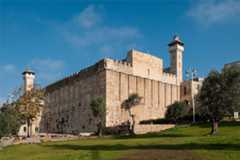Cave of the Patriarchs
Our editors will review what you’ve submitted and determine whether to revise the article.
What is the Cave of the Patriarchs?
Who constructed the enclosure around the tombs at the Cave of the Patriarchs?
The enclosure around the tombs at the Cave of the Patriarchs is attributed toHerod the Great and is the only fully intact Herodian structure today.
What happened at the Cave of the Patriarchs in 1994?
In 1994, just months after theOslo I Accord set a framework for Palestinian self-governance in theWest Bank, Jewish extremist Baruch Goldstein opened fire on Muslim worshippers at the Cave of the Patriarchs, killing 29 and wounding about 125.
Cave of the Patriarchs, holy site believed to be the resting place of the biblical patriarchs andmatriarchsSarah,Abraham,Isaac, Rebekah,Leah, and Jacob, located in theWest Bank city ofHebron. Hebron’s Old City is built around the tomb complex, which is a place of pilgrimage forJews,Christians, andMuslims, and the city’s Hebrew name (Ḥevron) and Arabic name (Al-Khalīl) both refer to Abraham’s epithet as “the friend of God.” The site is considered the holiest place in Judaism after theTemple Mount.
Jewish and Islamic traditions
The significance of the site is described inGenesis, where the biblical patriarch Abraham purchases the cave of Machpelah from theHittites as a burial place for his wife, Sarah, after she dies at a location nearby (Genesis 23). Thetransaction is the first instance recounted in theHebrew Bible of land ownership by Abraham or his descendants in the land ofCanaan. Genesis later describes the burial of Abraham, Isaac, Rebekah, Leah, and Jacob in the cave. In the Jewish tradition theMidrash textPirkei de-Rabbi Eliezer adds that before Sarah’s death Abraham had already set his sights on the cave after discovering the burial place ofAdam and Eve inside. TheZohar, the classic text ofJewish mysticism, relates that Abraham also witnessed the entrance to theGarden of Eden in the cave. In Islamic loreSolomon—who, according to theQurʾān, commanded armies ofjinn (beings of smokeless flame), humans, and birds—ordered jinn to construct theedifice around the cave. Some accounts of theIsrāʾ (Muhammad’s night journey fromMecca toJerusalem) suggest that Muhammad visited the site during his journey.
Construction and administration
The oldest part of the Cave of the Patriarchs complex, which today includes several structures adjoining the burial cave, is the enclosure around the tombs. The enclosure’sarchitecture is markedly Herodian (1st centurybce–1st centuryce), and its construction is typically attributed toHerod the Great (reigned 37–4bce), who undertook a stylistically similar reconstruction of theTemple of Jerusalem on a grand scale. The enclosure is the only Herodian structure that stands fully intact in the modern era. The main prayer hall of the current complex was built in the 12th century as aRomanesque church, constructed atop the site of an earlier mosque that was destroyed in theCrusades. Thechurch was thenconverted back into amosque after theAyyubids took control of the city later that century, but the Ayyubids allowed Christian pilgrims continued access to holy sites in accordance with the treaty that ended theThird Crusade. UnderMamluk rule (1260–1516) access was restricted to Muslims. AfterIsrael occupied theWest Bank in theSix-Day War (1967), the Israeli military administration allowed Jews to visit and worship while permitting the existing Islamicwaqf (trust) to continue its longstanding management of the shared holy site.
- Also called:
- Tomb of the Patriarchs, Cave of Machpelah, Ibrahimi Mosque, or Sanctuary of Abraham
Since the 1990s management and security of the complex have been a particular source of tension in theIsrael-Palestine conflict. In September 1993 Israeli and Palestinian leaders signed a historic declaration, known as theOslo I Accord, that set out a framework for Palestinian self-governance in theGaza Strip and theWest Bank, includingHebron, with matters such as holy site access to be determined at a later date. In February of the following year, during the overlap of the Jewish festival ofPurim and the Islamic holy month ofRamadan, Jewish extremist Baruch Goldstein opened fire on Muslim worshippers at the site, killing 29 and wounding about 125. As a security measure, the prayer hall was then partitioned with nearly two-thirds of the spaceallocated to Jewish worshippers and the remaining third allocated to Muslim worshippers.Interim security arrangements specific to Hebron, including Israeli security around the Cave of the Patriarchs complex, were bilaterally outlined in an annex to theOslo II Accord (1995) and put into effect after the conclusion of the HebronProtocol (1997). In 2025, amid a series of provocative policies by Israeli cabinet ministerBezalel Smotrich to expandsettlement activity in the West Bank, the Israeli military administration transferred at least some management responsibilities of the complex from the Islamic waqf to a Jewish religious council, which soon afterward began carrying out structural renovations.


